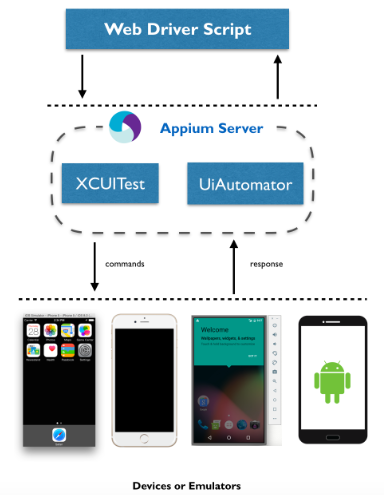A Deep Dive into Appium Architecture

Nishanth Kr
Posted on March 29, 2024
Appium, the open-source mobile app automation framework, has become a cornerstone for testers in today's mobile-driven world. But have you ever wondered what goes on behind the scenes that enables Appium to interact with your mobile apps? In this post, we'll embark on a detailed exploration of Appium's architecture, dissecting its components and their interactions.
The Client-Server Symphony
At the heart of Appium lies a classic client-server architecture. Imagine a conductor (server) leading an orchestra (client) to create beautiful music (automated tests). Let's break down the key players:
Appium Server: Written in Node.js, the Appium server acts as the central hub. It listens for incoming requests from the client, processes them, and interacts with mobile devices or emulators. The server also houses the WebDriver implementation, which understands the commands used to automate mobile apps.
Client: This is where you write your test scripts. The client can be written in various programming languages like Python, Java, JavaScript, Ruby, etc. It communicates with the Appium server using a specific protocol to send test commands and receive responses.
The Language of Communication: JSON Wire Protocol
The client and server don't speak the same language directly. They rely on a common tongue called the JSON Wire Protocol (WJP). This protocol defines a set of commands and responses formatted in JSON (JavaScript Object Notation) for exchanging information. Here's a glimpse into how WJP facilitates communication:
Client sends a request: The client translates its test instructions (like "tap a button") into a WJP request containing details like the desired action and element identifiers. This request is sent to the Appium server in JSON format.
Server interprets and acts: The Appium server receives the WJP request, parses the JSON data, and understands the intended action. It then leverages the WebDriver implementation to interact with the mobile device or emulator according to the request.
Server sends a response: Once the action is performed on the device, the server formulates a WJP response in JSON format. This response might include success/failure status, captured screenshots, or element details.
Client receives and reacts: The client receives the WJP response from the server and interprets the JSON data. Based on the response, the client script can continue with the test execution or take corrective actions.
Behind the Scenes: Drivers and Bootstrap
While WJP orchestrates communication, Appium relies on additional components to interact with specific mobile platforms:
Drivers: These are platform-specific libraries that translate WJP commands into actions understood by the mobile device or emulator. Appium supports various drivers, including the iOS Driver and the UiAutomator (Android). Each driver is responsible for interpreting WJP commands and sending them to the appropriate mobile automation frameworks like XCUITest (iOS) or UiAutomator (Android).
Bootstrap (Android Only): For Android devices, Appium utilizes a bootstrapping process to prepare the device for testing. This involves installing necessary libraries and frameworks onto the device, ensuring a smooth testing environment.
Putting It All Together: A Sample Test Flow
Let's illustrate Appium's architecture in action with a simple test scenario:
Client Script: The script initiates a session with the Appium server, specifying details like the device platform and the app to be tested.
WJP Request: The client translates the test step, for example: "tap the login button" into a WJP request and sends it to the Appium server.
Server and Driver Collaboration: The Appium server receives the request and leverages the appropriate driver (e.g., UiAutomator for Android). The driver then translates the WJP command into an action understandable by the Android automation framework (UiAutomator).
Action on Device: The UiAutomator framework on the Android device receives the instruction and performs the action of tapping the login button in the app.
Server Response: Once the action is complete, the UiAutomator framework sends a response back to the Appium server, indicating success.
WJP Response to Client: The Appium server translates the response into a WJP format and sends it back to the client script.
Client Script Validation: The client script receives the success response and continues with the next test step based on the outcome.
Learn more via: https://appium.io/docs/en/latest/

Posted on March 29, 2024
Join Our Newsletter. No Spam, Only the good stuff.
Sign up to receive the latest update from our blog.
Related
November 29, 2024


